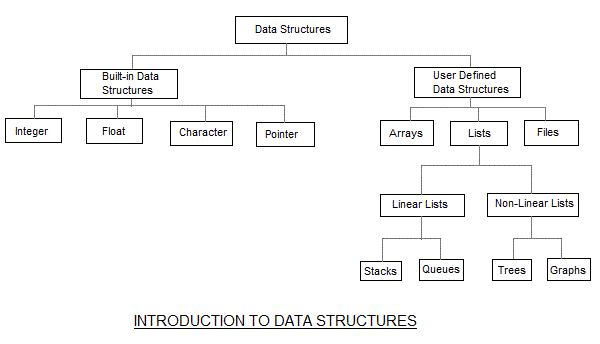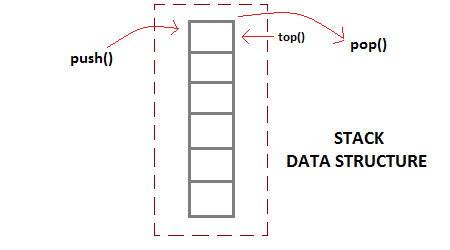In simple language, Data Structures are structures programmed to store ordered data, so that various operations can be performed on it easily.
Basic types of Data Structures
As we discussed above, anything that can store data can be called as a data strucure, hence Integer, Float, Boolean, Char etc, all are data structures. They are known as Primitive Data Structures.Then we also have some complex Data Structures, which are used to store large and connected data. Some example of Abstract Data Structure are :
- Linked List
- Tree
- Graph
- Stack, Queue etc.

What is Algorithm ?
An algorithm is a finite set of instructions or logic, written in order, to accomplish a certain predefined task. Algorithm is not the complete code or program, it is just the core logic(solution) of a problem, which can be expressed either as an informal high level description as pseudocode or using a flowchart.An algorithm is said to be efficient and fast, if it takes less time to execute and consumes less memory space. The performance of an algorithm is measured on the basis of following properties :
- Time Complexity - Time Complexity is a way to represent the amount of time needed by the program to run to completion. We will study this in details in our section.
- Space Complexity - Its the amount of memory space required by the algorithm, during the course of its execution. Space complexity must be taken seriously for multi-user systems and in situations where limited memory is available.
Time Complexity of Algorithms
Time complexity of an algorithm signifies the total time required by the program to run to completion. The time complexity of algorithms is most commonly expressed using the big O notation.Now the most common metric for calculating time complexity is Big O notation. This removes all constant factors so that the running time can be estimated in relation to N, as N approaches infinity. In general you can think of it like this :
statement;
Above we have a single statement. Its Time Complexity will be Constant. The running time of the statement will not change in relation to N.
for(i=0; i < N; i++)
{
statement;
}
The time complexity for the above algorithm will be Linear. The running time of the loop is directly proportional to N. When N doubles, so does the running time.
for(i=0; i < N; i++)
{
for(j=0; j < N;j++)
{
statement;
}
}
This time, the time complexity for the above code will be Quadratic. The running time of the two loops is proportional to the square of N. When N doubles, the running time increases by N * N.
Types of Sorting Techniques
- Bubble Sort
- Insertion Sort
- Selection Sort
- Quick Sort
- Merge Sort
- Heap Sort
Stacks
Stack is an abstract data type with a bounded(predefined) capacity. It is a simple data structure that allows adding and removing elements in a particular order. Every time an element is added, it goes on the top of the stack, the only element that can be removed is the element that was at the top of the stack, just like a pile of objects.
Stack can be easily implemented using an Array or a Linked List. Arrays are quick, but are limited in size and Linked List requires overhead to allocate, link, unlink, and deallocate, but is not limited in size. Here we will implement Stack using array.
Class Stack
{
int top;
public:
int a[10]; //Maximum size of Stack
Stack()
{
top = -1;
}
};
void Stack::push(int x)
{
if( top >= 10)
{
cout << "Stack Overflow";
}
else
{
a[++top] = x;
cout << "Element Inserted";
}
}
int Stack::pop()
{
if(top < 0)
{
cout << "Stack Underflow";
return 0;
}
else
{
int d = a[top--];
return d;
}
}
void Stack::isEmpty()
{
if(top < 0)
{
cout << "Stack is empty";
}
else
Queue
Queue is also an abstract data type or a linear data structure, in which the first element is inserted from one end called REAR(also called tail), and the deletion of exisiting element takes place from the other end called as FRONT(also called head). This makes queue as FIFO data structure, which means that element inserted first will also be removed first.
Queue can be implemented using an Array, Stack or Linked List. The easiest way of implementing a queue is by using an Array. Initially the head(FRONT) and the tail(REAR) of the queue points at the first index of the array (starting the index of array from 0). As we add elements to the queue, the tail keeps on moving ahead, always pointing to the position where the next element will be inserted, while the head remains at the first index.
Linked Lists
Linked List is a linear data structure and it is very common data structure which consists of group of nodes in a sequence which is divided in two parts. Each node consists of its own data and the address of the next node and forms a chain. Linked Lists are used to create trees and graphs.Advantages of Linked Lists:
- They are a dynamic in nature which allocates the memory when required.
- Insertion and deletion operations can be easily implemented.
- Stacks and queues can be easily executed.
- Linked List reduces the access time.
Singly Linked List : Singly linked lists contain nodes which have a data part as well as an address part i.e. next, which points to the next node in sequence of nodes. The operations we can perform on singly linked lists are insertion, deletion and traversals

Doubly Linked List : In a doubly linked list, each node contains two links the first link points to the previous node and the next link points to the next node in the sequence.

Circular Linked List : In the circular linked list the last node of the list contains the address of the first node and forms a circular chain.

No comments:
Post a Comment